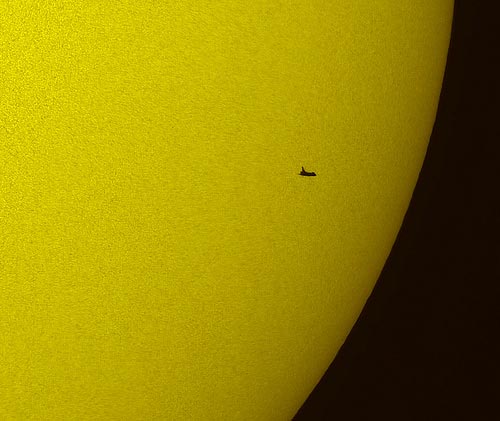Space Shuttle, Hubble Spotted Crossing the Sun

HOUSTON ? Stunning new images reveal the space shuttleAtlantis and the Hubble Space Telescope as the two spacecraft were silhouettedby the sun earlier this week.
The images were taken on May 12 and May 13 by photographerThierry Legault before Atlantis astronauts grabbed onto Hubble with theshuttle?s robotic arm to begin a series of challenging spacewalks to overhaulthe space telescope for the fifth and final time.
The spacecraft were zooming around Earth at 17,500 mph(28,163 kph) at an altitude of nearly 350 miles (563 km). Both spacecrafttransited across the face of the sun in 0.8 seconds, according to Legault.
The two spaceships appear as tiny dark pinpricks on theexpansive face of an otherwise unblemished sun. But in tightly cropped shots,the two spacecraft can easily be seen.
In the May 12 snapshot, Atlantis appears as a clearlyrecognizable shuttle in silhouette. Its nose is facing toward the limb of thesun and the shuttle?s tail, aft and starboard wingtip can be discerned.
The May 13 image is even more revealing. There, Legaultcaught both Atlantis and Hubble just before astronauts grappled the space telescope.The belly of Atlantis appears to be facing away from the higher Hubble, so itsfull outline reveals both wings, the nose and tail.
The school bus-sized Hubble is not as clear and appears asdark spot against the sun to the lower right of Atlantis. NASA?s space shuttlesare 122 feet (37 meters) long with a wingspan of about 78 feet (24 meters).Hubble is nearly 44 feet (13 meters) long and 14 feet (4 meters) in diameter atits widest point.
Get the Space.com Newsletter
Breaking space news, the latest updates on rocket launches, skywatching events and more!
The sun is going through a quiet phase of its 11-year solarcycle that has left it nearly barren of sunspots. It is expected to hit amild peak in 2013.
Legault caught the transit of Atlantis and Hubble across thesun from Vero Beach, Fla. The shuttle launched toward Hubble on Monday from theKennedy Space Center in nearby Cape Canaveral, Fla., on an 11-day mission to upgradeHubble. The mission is aimed at extending the telescope?s life through 2014.
- New Video Show - Hubble's Final Shuttle Service Call
- Video - See the Space Station from Earth
- Gallery: The Wild and Stormy Sun
Join our Space Forums to keep talking space on the latest missions, night sky and more! And if you have a news tip, correction or comment, let us know at: community@space.com.

Tariq is the Editor-in-Chief of Space.com and joined the team in 2001, first as an intern and staff writer, and later as an editor. He covers human spaceflight, exploration and space science, as well as skywatching and entertainment. He became Space.com's Managing Editor in 2009 and Editor-in-Chief in 2019. Before joining Space.com, Tariq was a staff reporter for The Los Angeles Times covering education and city beats in La Habra, Fullerton and Huntington Beach. In October 2022, Tariq received the Harry Kolcum Award for excellence in space reporting from the National Space Club Florida Committee. He is also an Eagle Scout (yes, he has the Space Exploration merit badge) and went to Space Camp four times as a kid and a fifth time as an adult. He has journalism degrees from the University of Southern California and New York University. You can find Tariq at Space.com and as the co-host to the This Week In Space podcast with space historian Rod Pyle on the TWiT network. To see his latest project, you can follow Tariq on Twitter @tariqjmalik.










